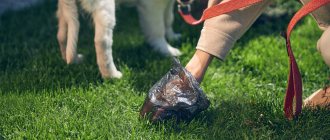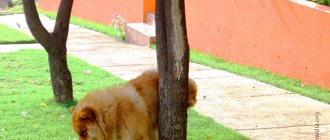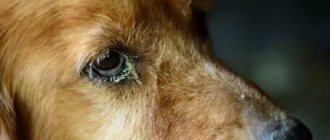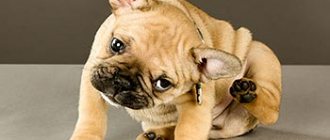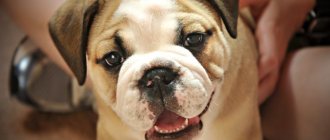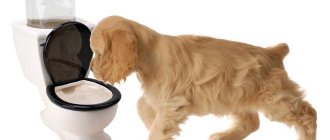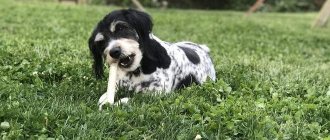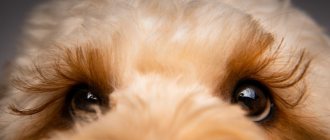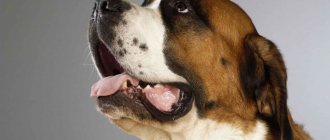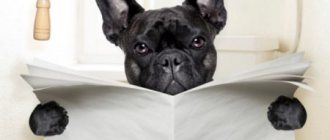Owners can easily notice some pathological changes in a pet’s body on their own – by looking at excrement. Their consistency should be soft, oblong in shape, and dark brown in color. If your dog's poop turns white, this is a serious cause for concern.
Green stool
Stool acquires its green color due to the large secretion of bile or bile enzymes known as bilirubin and biliverdin. There may be several reasons for the appearance of such bowel movements:
- Inflammation of the gastrointestinal tract.
- Fungal infectious diseases, in which a fungal colony is able to multiply in the internal tissues and organs of the dog, disrupting their functions.
- Parasitic diseases caused by helminths, insect bites and other factors.
- Pathological abnormalities in the functioning of the liver and bile ducts.
- Cholelithiasis. The formation of stones in the gallbladder or bile ducts leads to stagnation of bile and is dangerous for the rupture of the gallbladder.
- External parasites. These include mites, scabies, lice-eaters and other blood-sucking representatives.
- Errors in diet planning. If the dog is prone to allergic reactions, manifestations of dysbacteriosis, or with an incorrectly selected diet, green stool can be a single symptom without causing pain in the animal. However, it is necessary to understand that a malfunction has occurred in the body’s functioning and, without treatment, the pet’s condition will significantly worsen.
Often, green stool is accompanied by a liquid consistency, which may be an indicator of a putrefactive process in the dog’s intestines. This is an alarming and dangerous symptom of a disease that poses a threat to the pet’s life.
Other Causes of Yellow Diarrhea in Dogs
In dogs of decorative, miniature breeds, and in puppies, loose yellow stools are very often provoked by ready-made industrial food of low quality . They contain a large amount of flavorings, stabilizers, fats, and fiber (more than 20%). These components not only affect the color and consistency of stool, but are also not properly absorbed in the dog’s body, so they are excreted unchanged in the stool, causing stomach upset.
Other causes of loose yellow stool include fear, severe emotional stress, frequent stress, and allergic reactions . Diarrhea in dogs can be caused by hypersensitivity of the animal's body to certain substances that are part of concentrated, dry food or medicinal components.
In some cases, yellow diarrhea is noted a few days after vaccination or antibiotic therapy . Antibiotics inhibit beneficial intestinal microflora and can cause dysbacteriosis.
White stool
The white color of feces, first of all, indicates tumor formations in the liver, gall bladder or digestive organs. Such excrement may indicate the following disorders in the body:
- Malignant tumors of the liver or gallbladder disrupt the normal flow of bile.
- Inflammation of the pancreas (pancreatitis).
- Inflammation of the liver and bile ducts (cholangiohepatitis, cholangitis).
- Inflammatory process in the liver (infectious and toxic hepatitis).
- Liver failure with threat of liver cirrhosis.
- The formation of cystic nodes in the liver and disruption of the functions of this important organ.
- Changes in the gallbladder - its deformation, reduction in size.
- Excessive consumption of foods with high fat content (pork, sour cream) or other unusual foods. In the absence of other symptoms (vomiting, abdominal pain, apathy), it is allowed to monitor the dog’s stool for one day before going to the clinic, provided that the owner is sure that the origin of the white feces is due to an error in the diet.
Traditional methods of treatment
At home, after consulting with a veterinarian, the main treatment can be supplemented with alternative medicine. For a dog with diarrhea, you can give a steep rice decoction, a decoction of chamomile, oak bark, cinquefoil, and St. John's wort.
Healing plants must have astringent, anti-inflammatory, and restorative properties . Healing compositions and tinctures are given to the pet three to five times a day, one tablespoon. The dosage is selected taking into account the age and body weight of the dog.
For severe diarrhea, an infusion of pomegranate peel will help at the initial stage. Pour dry, pre-washed peel with warm boiled water at the rate of 15 g per 300 ml of water. Leave for 35-40 minutes. Give a dog with diarrhea one tablespoon every hour, but no more than two to three days.
Black stool
The black color of the stool indicates the presence of blood in it. If the bright red color of the blood indicates the formation of bleeding in the large intestine or in the anal area, then the dark color of the discharge indicates that it has been processed by enzymes and the cause of its occurrence is located in the digestive tract or small intestine.
So, black feces may indicate the presence of serious problems in the pet’s health:
- Presence of helminths. By parasitizing the intestinal mucosa and destroying it, helminths gain access to the dog’s blood. Some of the blood enters the intestines, from where it is excreted.
- Infectious diseases – parvovirus enteritis. If you are infected with a dangerous infection, you need to know that blood discharge does not come out as a homogeneous mass with the dog’s stool, but is contained in small clots.
- Stomach ulcer. This dangerous disease is associated with internal gastrointestinal bleeding, which explains the appearance of dark discharge in the dog's stool.
- Hemorrhagic gastroenteritis occurs as a result of inflammation of the stomach and intestines. Complications from infectious diseases, stressful situations (for example, during medical therapy), circulatory disorders - all these are the causes of this dangerous disease.
- Damage to the walls of the gastrointestinal tract by a foreign object. It is dangerous if your pet swallows a hard and sharp object, which can cause tissue damage and cause internal bleeding.
The appearance of loose black stool indicates extensive internal bleeding and is extremely dangerous for the pet’s life.
What does the ideal chair look like?
Dog stool has four main parameters: color, content, consistency and coating. Healthy dog poop should be chocolate brown in color. As for its contents, let your veterinarian do all the “dirty” work. Most people won't be able to see much of anything there without a microscope. Healthy dog poop should be slightly firm in consistency, like modeling clay. Ideally, it should be in the shape of a log with small cracks. If you wanted to roll it, it would fall apart into small pieces. Finally, healthy stool has no surface coating at all. So if your dog has chocolate brown, slightly hard, uncoated stool with nothing sticking out, then everything is fine. However, be aware of the signs that may indicate health problems.
Yellow stool
The yellow color of an animal's stool can indicate either a problematic health condition or be the result of consuming foods containing carotene.
Yellow feces are characteristic of such abnormalities as:
- Liver dysfunction (cirrhosis, hepatitis, neoplasia). A yellowish tint to feces appears when the liver malfunctions; it is intermediate and characterizes the transition to lightening of feces to a white color.
- Presence of helminths. The color may be yellowish due to the presence of worms and their larvae in the feces.
- Malfunction of the pancreas. Due to disturbances in the production of hormones, the body cannot cope with the processing of fats and feces acquire an oily sheen and a yellow color.
- Eating foods containing carotene (carrots, cereals, etc.). The animal’s body does not digest carotene and excretes it intact.
Reasons for the formation of yellow loose stools:
- intestinal infections;
- infection with a viral infection, for example salmonellosis, parvovirus;
- incorrect diet.
What to do if your dog has yellow diarrhea
Before treatment for profuse diarrhea is prescribed, it is very important to conduct a comprehensive diagnosis. Diagnostic techniques in combination with clinical manifestations will help to establish the root cause of indigestion.
Important! Yellow diarrhea that lasts more than a day poses a real danger to the health and life of small puppies, especially if other symptoms are present in addition to diarrhea.
If a dog has yellow diarrhea that is a symptom of parvovirus enteritis, adenovirus, treatment should be prescribed as soon as possible. A viral disease provokes leukopenia, erosive and ulcerative formations on the intestinal walls, and hepatic coma. If left untreated, infections can cause the death of pets due to severe intoxication and dehydration.
Four-legged patients are prescribed complex anti-inflammatory, antiviral drugs, tetracycline and cephalosporin antibiotics, and sulfonamides. The choice of antibacterial drug depends on the strain, degree of virulence, and serotype of the infectious agent.
To normalize the water-salt balance, dogs are given droppers and physiological solutions are injected intravenously (Regidron, Ringer-Locke solution).
Immediately after yellow diarrhea appears, you should keep your pet on a starvation diet . In this case, drinking should be in unlimited quantities. If the animal refuses to drink water on its own, it is injected into the pet’s mouth with a syringe without a needle or an introducer.
For severe diarrhea, therapeutic therapy is aimed at normalizing the general condition, stabilizing intestinal motility, and activating intestinal microflora. Dogs are prescribed enzymes, probiotics, adsorbents to neutralize toxins, and antidiarrheal medications (Phthalazol, Loperamide). Enetrosgel, Smecta, Papaverine help well with diarrhea. To relieve painful spasms in the gastrointestinal tract, animals are prescribed No-shpu, Drotaverine, and other analgesics in tablets, capsules, and injections.
Prevention of the condition
To prevent this condition of the animal, you should:
- give up fatty foods;
- monitor the dog’s hygiene;
- regularly add vitamins and microelements to the feed;
- monitor your pet's health.
The right approach to diet will help avoid diarrhea and changes in stool color.
Knowing why a dog may have yellow stool and what diseases such a symptom is a harbinger of, the owner will be able to provide timely help to the pet. It is enough to fulfill a number of conditions: reduce the amount of fatty foods, undergo regular examinations and examinations by a veterinarian and maintain hygiene.
Feeding a dog with diarrhea
When a dog has diarrhea, it is very important to adjust the diet. A pet's diet should be balanced, nutritious and healthy. Strictly follow all recommendations of your doctor. Observe the frequency of dosing and do not interrupt the treatment course.
Food, as soon as your pet’s stool returns to normal, should be easily digestible. Eliminate high-protein foods, fatty cottage cheese, and other fermented milk products from your diet . Don't give your dog heavy food. Raw river and sea fish, offal that has not undergone heat treatment, fatty meats, as well as any products from our table are prohibited.
If the animal is kept on a natural diet, you can give your pet porridge cooked in vegetable or chicken broth, boiled poultry, veal, or minced beef. Make sure your food is always fresh. You can pamper your dog with “sugar” bones, veal tail, biscuits, and unsweetened crackers.
During and after treatment, monitor the behavior and health of the dog, as well as the consistency and color of the stool. If the condition worsens or relapses occur, contact your veterinarian. Remember, any pathology or disease is much easier to cure at the initial stage of development.
When to call an ambulance
Although the mucus may disappear on its own or go away over time, there are cases when it is necessary to urgently call an ambulance:
- If diarrhea with mucus is simultaneously accompanied by severe and incessant vomiting
- Body temperature has increased significantly
- There is blood in the stool
- The child poops more than twelve times a day, and loosely
- If the child is not gaining weight well, namely the increase is less than 125 grams per month
- Bad breath
- Urinating about 6 times a day, and the smell of urine is unpleasant
If the following symptoms are detected, it is best to call an emergency room so as not to delay the process for too long and to prevent complications from developing.
